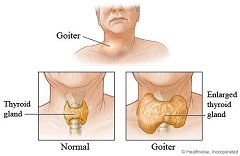A goitre (BrE), or goiter (AmE) (Latin struma), also called a bronchocele, is a swelling in the neck (just below the Adam’s apple or larynx) due to an enlarged thyroid gland.
Classification of Goitre
They are classified in different ways:
- A “diffuse goiter” is a goiter that has spread through all of the thyroid (and can be a “simple goitre”, or a “multinodular goitre”).
- “Toxic goitre” refers to goitre with hyperthyroidism. These most commonly due to Graves’ disease, but can be caused by inflammation or a multinodular goitre.
- “Nontoxic goitre” (associated with normal or low thyroid levels) refers to all other types (such as that caused by lithium or certain other autoimmune diseases).
Other type of classification:
- I – palpation struma – in normal posture of head it cannot be seen. Only found when palpating.
- II – struma is palpative and can be easily seen.
- III – struma is very big and is retrosternal. Pressure and compression marks.
Causes of Goitre
Other causes are:
- Hashimoto’s thyroiditis (E06.3)
- Graves-Basedow disease (E05.0)
- Inborn errors of thyroid hormone synthesis, causing congenital hypothyroidism (E03.0)
- Thyroiditis (acute, chronic) (E06)
- Side-effects of pharmacological therapy (E03.2)
- Thyroid cancer
- Iodine deficiency
Occurrence
Iodine is necessary for the synthesis of the thyroid hormones thyroxine (T4) and triiodothyronine (T3). In endemic goitre, iodine deficiency leaves the thyroid gland unable to produce its hormones because the hormones are made out of iodine. When levels of thyroid hormones fall, thyrotropin-releasing hormone (TRH) is produced by the hypothalamus. TRH then prompts the pituitary gland to make thyrotropin or thyroid stimulating hormone (TSH), which stimulates the thyroid gland’s production of T4 and T3. It also causes the thyroid gland to grow in size by increasing cell division.

Nodular goitre of a young south asian woman.
Goitre is more common among women, but this includes the many types of goitre caused by autoimmune problems, and not only those caused by simple lack of iodine.
Treatment of Goitre
Treatment may not be necessary if the goitre is small. Goitre may be related to hyper- and hypothyroidism (especially Graves’ disease) and may be reversed by treatment of hyper- and hypothyroidism. Grave’s disease can be corrected with antithyroid drugs (such as propylthiouracil and methimazole), thyroidectomy (surgical removal of the thyroid gland), and iodine-131 (a radioactive isotope of iodine that is absorbed by the thyroid gland and destroys it). Hypothyroidism may raise the risk of goitre because it usually increases the production of TRH and TSH. Levothyroxine, used to treat hypothyroidism, can also be used in euthyroid patients for the treatment of goitre. Levothyroxine suppressive therapy decreases the production of TRH and TSH and may reduce goitre, thyroid nodules, and thyroid cancer. Blood tests are needed to ensure that TSH is still in range and the patient has not become subclinically hyperthyroid. If TSH levels are not carefully monitored, levothyroxine may increase the risk of osteoporosis.
Thyroidectomy or 131 may be necessary in euthyroid goitrous patients who do not respond to levothyroxine treatment, especially if the patients have difficulty breathing or swallowing. 131, with or without the pre-injection of synthetic TSH, can relieve obstruction and reduce the size of the goitre by thirty to sixty-five percent. Depending on how large the goitre is and how much of the thyroid gland must be removed or destroyed, thyroidectomy or 131 may produce hypothyroidism requiring life-long treatment.
History and future
In the 12th century, al-Jurjani, a Persian physician, provided the first description of Graves’ disease after noting the association of goitre and exophthalmos in his Thesaurus of the Shah of Khwarazm, the major medical dictionary of its time.[1][2] Al-Jurjani also established an association between goitre and palpitation.[3] The disease was later named after Irish doctor Robert James Graves,[4] who described a case of goiter with exophthalmos in 1835. The German Karl Adolph von Basedow also independently reported the same constellation of symptoms in 1840, while earlier reports of the disease were also published by the Italians Giuseppe Flajani and Antonio Giuseppe Testa, in 1802 and 1810 respectively,[5] and by the English physician Caleb Hillier Parry (a friend of Edward Jenner) in the late 18th century.[6]
Paracelsus (1493–1541) was the first person to propose a relationship between goitre and minerals (particularly lead) in drinking water.[7] Iodine was later discovered by Bernard Courtois in 1811 from seaweed ash.
Goitre was previously common in many areas that were deficient in iodine in the soil. For example, in the English Midlands, the condition was known as Derbyshire Neck. In the United States, goitre was found in the Great Lakes, Midwest, and Intermountain regions. The condition now is practically absent in affluent nations, where table salt is supplemented with iodine. However, it is still prevalent in India,[8] Central Asia and Central Africa.
Some health workers fear that a resurgence of goitre might occur because of the trend to use rock salt and/or sea salt, which has not been fortified with iodine. New research indicates that there may in fact be a tendency to inherit an increased vulnerability to goitre.
Famous goitre sufferers
- President George H. W. Bush and his wife Barbara Bush both were diagnosed with Graves’ disease and goitres, within two years of each other. In the president’s case, the disease caused hyperthyroidism and cardiac dysrhythmia. Even the Bushs’ dog Millie was diagnosed with an autoimmune disease: lupus.[9][10][11][12] Scientists said that the odds of both George and Barbara Bush having Graves’ disease might be 1 in 100,000 or as low as 1 in 3,000,000[13]
- Andrea True (according to an interview on VH-1) [14]
- Kim Il-sung
Homeopathy Treatment for Goitre
Keywords: homeopathy, homeopathic, treatment, cure, remedy, remedies, medicine
Homeopathy treats the person as a whole. It means that homeopathic treatment focuses on the patient as a person, as well as his pathological condition. The homeopathic medicines are selected after a full individualizing examination and case-analysis, which includes the medical history of the patient, physical and mental constitution, family history, presenting symptoms, underlying pathology, possible causative factors etc. A miasmatic tendency (predisposition/susceptibility) is also often taken into account for the treatment of chronic conditions. A homeopathy doctor tries to treat more than just the presenting symptoms. The focus is usually on what caused the disease condition? Why ‘this patient’ is sick ‘this way’. The disease diagnosis is important but in homeopathy, the cause of disease is not just probed to the level of bacteria and viruses. Other factors like mental, emotional and physical stress that could predispose a person to illness are also looked for. No a days, even modern medicine also considers a large number of diseases as psychosomatic. The correct homeopathy remedy tries to correct this disease predisposition. The focus is not on curing the disease but to cure the person who is sick, to restore the health. If a disease pathology is not very advanced, homeopathy remedies do give a hope for cure but even in incurable cases, the quality of life can be greatly improved with homeopathic medicines.
The homeopathic remedies (medicines) given below indicate the therapeutic affinity but this is not a complete and definite guide to the homeopathy treatment of this condition. The symptoms listed against each homeopathic remedy may not be directly related to this disease because in homeopathy general symptoms and constitutional indications are also taken into account for selecting a remedy. To study any of the following remedies in more detail, please visit the Materia Medica section at hussainkaisrani.com.
None of these medicines should be taken without professional advice and guidance.
Homeopathy Remedies for Goitre :
Adren., ail., aloe., am-c., am-m., ambr., apis., ars-i., arum-t., aur., aur-i., aur-s., bad., bar-i., bell., brom., calc., calc-f., calc-i., calc-s., carb-an., carb-s., caust., chr-s., cist., cob., con., crot-c., dys-co., ferr., ferr-i., fl-ac., form., fuc., glon., graph., hep., hydr., hydr-ac.,iod., iris., kali-c., kali-i., lach., lap-a., lycps., lyc., mag-c.,mag-p., mang., merc., merc-i-f., merc-i-r., morg., nat-c., nat-m., nat-p., nat-s., phos., phyt., pineal., plat., podo., puls., sep., sil., spong., stram., sulph., syc-co., tab., tarent., thyr., tub., urt-u.
References
- ^ Basedow’s syndrome or disease at Who Named It – the history and naming of the disease
- ^ Ljunggren JG (August 1983). “[Who was the man behind the syndrome: Ismail al-Jurjani, Testa, Flagani, Parry, Graves or Basedow? Use the term hyperthyreosis instead]”. Lakartidningen 80 (32-33): 2902. PMID 6355710.
- ^ Nabipour, I. (2003), “Clinical Endocrinology in the Islamic Civilization in Iran”, International Journal of Endocrinology and Metabolism 1: 43–45 [45]
- ^ Robert James Graves at Who Named It
- ^ Giuseppe Flajani at Who Named It
- ^ Hull G (1998). “Caleb Hillier Parry 1755-1822: a notable provincial physician“. Journal of the Royal Society of Medicine 91 (6): 335–8. PMID 9771526.
- ^ “Paracelsus” Britannica
- ^ “In Raising the World’s I.Q., the Secret’s in the Salt”, article by Donald G. McNeil, Jr., December 16, 2006, New York Times
- ^ The Health and Medical History of President George Bush DoctorZebra.com. 8 August 2004. Retrieved 8 October 2006.
- ^ “George H.W. Bush.” NNDB.
- ^ Robert G. Lahita and Ina Yalof. Women and Autoimmune Disease: The Mysterious Ways Your Body Betrays Itself. Page 158.
- ^ Lawrence K. Altman, M.D. “Doctors Say Bush Is in Good Health.” The New York Times. September 14, 1991.
- ^ [http://query.nytimes.com/gst/fullpage.html?res=9D0CE7DD1039F93BA15756C0A967958260&sec=&spon=&pagewanted=1 Lawrence K. Altman, M.D. “The Doctor’s World; A White House Puzzle: Immunity Ailments.” The New York Times. May 28, 1991]
- ^ [ http://celebrity.elle.com/celebrity-Andrea+True “Andrea True.” Elle.]
Related posts:



